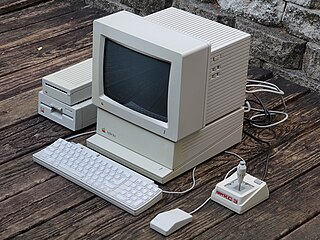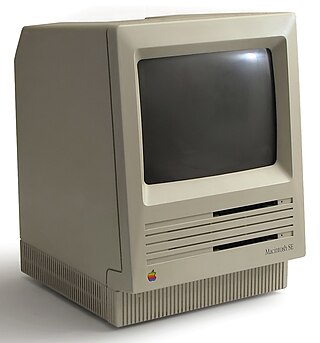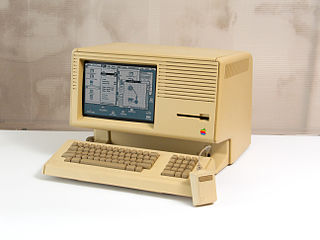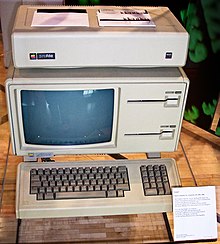
The Apple II series of microcomputers was initially designed by Steve Wozniak, manufactured by Apple Computer, and launched in 1977 with the Apple II model that gave the series its name. It was followed by the Apple II Plus, Apple IIe, Apple IIc, and Apple IIc Plus, with the 1983 IIe being the most popular. The name is trademarked with square brackets as Apple ][, then, beginning with the IIe, as Apple //. In terms of ease of use, features, and expandability, the Apple II was a major advancement over its predecessor, the Apple I, a limited-production bare circuit board computer for electronics hobbyists.

Lisa is a desktop computer developed by Apple, produced from January 19, 1983 to August 1, 1986, and succeeded by Macintosh. It is generally considered the first mass-market personal computer operable through a graphical user interface (GUI). In 1983, a machine like the Lisa was still so expensive that it was primarily marketed to individual and small and medium-sized businesses as a groundbreaking new alternative to much bigger and more expensive mainframes or minicomputers such as from IBM, that either require additional, expensive consultancy from the supplier, hiring specially trained personnel, or at least, a much steeper learning curve to maintain and operate. Earlier GUI-controlled personal computers were not mass-marketed; for example, Xerox PARC manufactured its Alto workstation only for Xerox and select partners from the early to mid-1970s.

The Macintosh Plus computer is the third model in the Macintosh line, introduced on January 16, 1986, two years after the original Macintosh and a little more than a year after the Macintosh 512K, with a price tag of US$2,599. As an evolutionary improvement over the 512K, it shipped with 1 MB of RAM standard, expandable to 4 MB, and an external SCSI peripheral bus, among smaller improvements. Originally, the computer's case was the same beige color as the original Macintosh, Pantone 453; however, in 1987, the case color was changed to the long-lived, warm gray "Platinum" color. It is the earliest Macintosh model able to run System Software 5, System 6, and System 7, up to System 7.5.5, but not System 7.5.2.

The Macintosh II is a personal computer designed, manufactured, and sold by Apple Computer from March 1987 to January 1990. Based on the Motorola 68020 32-bit CPU, it is the first Macintosh supporting color graphics. When introduced, a basic system with monitor and 20 MB hard drive cost US$5,498. With a 13-inch color monitor and 8-bit display card, the price was about US$7,145. This placed it in competition with workstations from Silicon Graphics, Sun Microsystems, and Hewlett-Packard.

The Apple IIGS is a 16-bit personal computer produced by Apple Computer. It is the fifth and most powerful of the Apple II family. It is compatible with earlier Apple II models, but has a Macintosh look and feel, and resolution and color similar to the Amiga and Atari ST. The "GS" in the name stands for "Graphics and Sound", referring to its enhanced multimedia hardware, especially its state-of-the-art audio.

The Macintosh SE is a personal computer designed, manufactured, and sold by Apple Computer, from March 1987 to October 1990. It marked a significant improvement on the Macintosh Plus design and was introduced by Apple at the same time as the Macintosh II.

The Macintosh, later rebranded as the Macintosh 128K, is the original Macintosh personal computer from Apple. It is the first successful mass-market all-in-one desktop personal computer with a graphical user interface, built-in screen and mouse. It was pivotal in establishing desktop publishing as a general office function. The motherboard, a 9 in (23 cm) CRT monochrome monitor, and a floppy drive are in a beige case with integrated carrying handle; it has a keyboard and single-button mouse.

The Macintosh 512K is a personal computer that was designed, manufactured and sold by Apple Computer from September 1984 to April 1986. It is the first update to the original Macintosh 128K. It was virtually identical to the previous Macintosh, differing primarily in the amount of built-in random-access memory. The increased memory turned the Macintosh into a more business-capable computer and gained the ability to run more software. It is the earliest Macintosh model that can be used as an AppleShare server and, with a bridge Mac, communicate with modern devices.

Macintosh XL is a modified version of the Apple Lisa personal computer made by Apple Computer. In the Macintosh XL configuration, the computer shipped with MacWorks XL, a Lisa program that allowed 64 K Macintosh ROM emulation. An identical machine was previously sold as Lisa 2/10 with the Lisa OS only.

The Macintosh Classic II is a personal computer designed and manufactured by Apple Computer, Inc. from October 1991 to September 1993. The system has a compact, appliance design with an integrated 9" monitor, typical of the earliest of the Macintosh range. A carrying handle moulded into the case added a degree of portability at a time when laptops were still relatively uncommon.

The Macintosh Quadra 950 is a personal computer designed, manufactured and sold by Apple Computer from March 1992 to October 1995. It replaced the Quadra 900 that was introduced several months earlier, increasing the CPU clock rate of its 68040 CPU from 25 MHz to 33 MHz, and improving the graphics support. The two computers were otherwise identical, including the price. With a Macintosh Processor Upgrade Card installed, this computer is known as the Power Macintosh 950.

Applied Engineering, headquartered in Carrollton, Texas, was a leading third-party hardware vendor for Apple II computers from the early 1980s until the mid-1990s.

The Disk II Floppy Disk Subsystem, often rendered as Disk ][, is a 5 +1⁄4-inch floppy disk drive designed by Steve Wozniak at the recommendation of Mike Markkula, and manufactured by Apple Computer It went on sale in June 1978 at a retail price of US$495 for pre-order; it was later sold for $595 including the controller card and cable. The Disk II was designed specifically for use with the 1977 Apple II personal computer to replace the slower cassette tape storage.
The Macintosh Hard Disk 20 is the first hard drive developed by Apple Computer specifically for use with the Macintosh 512K. Introduced on September 17, 1985, it was part of Apple's solution toward completing the Macintosh Office announced in January 1985. It would be over a year more before Apple would release the file server software AppleShare that would link all of the hardware together. By that time the SCSI interface introduced on the Macintosh Plus in January 1986, would accommodate far faster and more efficient hard drives, rendering the Hard Disk 20 virtually obsolete.

The Apple Hard Disk 20SC is Apple's first SCSI based hard drive for the Apple II family as well as the Macintosh and other third party computers using an industry standard SCSI interface.
The Macintosh Office was an effort by Apple Computer to design an office-wide computing environment consisting of Macintosh computers, a local area networking system, a file server, and a networked laser printer. Apple announced Macintosh Office in January 1985 with a poorly received sixty-second Super Bowl commercial dubbed Lemmings. In the end, the file server would never ship and the Office project would be cancelled. However, the AppleTalk networking system and LaserWriter printer would be hugely successful in launching the desktop publishing revolution.

The Seagate Barracuda is a series of hard disk drives and later solid state drives produced by Seagate Technology that was first introduced in 1993.

The Macintosh External Disk Drive is the original model in a series of external 3+1⁄2-inch floppy disk drives manufactured and sold by Apple Computer exclusively for the Macintosh series of computers introduced in January 1984. Later, Apple unified their external drives to work cross-platform between the Macintosh and Apple II product lines, dropping the name "Macintosh" from the drives. Though Apple had been producing external floppy disk drives prior to 1984, they were exclusively developed for the Apple II, III and Lisa computers using the industry standard 5+1⁄4-inch flexible disk format. The Macintosh external drives were the first to widely introduce Sony's new 3+1⁄2-inch rigid disk standard commercially and throughout their product line. Apple produced only one external 3+1⁄2-inch drive exclusively for use with the Apple II series called the Apple UniDisk 3.5.
















